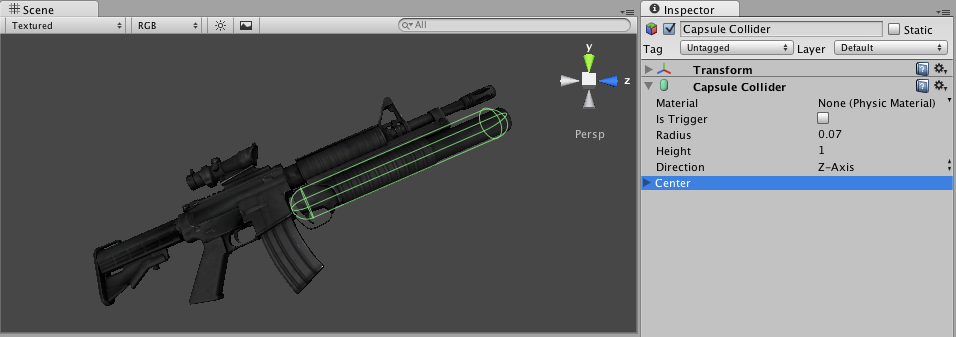Configure Rigidbody Colliders
CollidersAn invisible shape that is used to handle physical collisions for an object. A collider doesn’t need to be exactly the same shape as the object’s mesh - a rough approximation is often more efficient and indistinguishable in gameplay. More info
See in Glossary define the physical boundaries of a RigidbodyA component that allows a GameObject to be affected by simulated gravity and other forces. More info
See in Glossary. To allow collisions to occur, you must add Colliders to a GameObjectThe fundamental object in Unity scenes, which can represent characters, props, scenery, cameras, waypoints, and more. A GameObject’s functionality is defined by the Components attached to it. More info
See in Glossary alongside a Rigidbody.
If one Rigidbody collides with another, the physics engineA system that simulates aspects of physical systems so that objects can accelerate correctly and be affected by collisions, gravity and other forces. More info
See in Glossary only calculates a collision if both GameObjects have a Collider attached. If one GameObject has a Rigidbody but no Collider, it passes through other GameObjects, and Unity does not include it in collision calculations.

The relative Mass of each Rigidbody in a collision determines how they react when they collide with each other.
See CollisionA collision occurs when the physics engine detects that the colliders of two GameObjects make contact or overlap, when at least one has a Rigidbody component and is in motion. More info
See in Glossary for more information.
Convex and concave collider geometry
The PhysX physics system requires that any collider you place on a non-kinematic Rigidbody is convex, not concave. All primitive shapes in Unity are convex. However, Unity considers a Mesh ColliderA free-form collider component which accepts a mesh reference to define its collision surface shape. More info
See in Glossary concave by default.
If you apply a default MeshThe main graphics primitive of Unity. Meshes make up a large part of your 3D worlds. Unity supports triangulated or Quadrangulated polygon meshes. Nurbs, Nurms, Subdiv surfaces must be converted to polygons. More info
See in Glossary Collider to a non-kinematic Rigidbody, Unity throws an error at runtime. To ensure that your non-kinematic Rigidbody receives physics-based forces, you need to instruct Unity to make the Mesh Collider convex. To do this, enable the Mesh Collider’s Convex property. When Convex is enabled, Unity automatically calculates a convex collider shape (called a hull) based on the associated mesh. However, because the convex hull of the mesh is only an approximation of the original shape, it can lead to inaccurate simulation.
For a more accurate collision simulation, you can use one of the following approaches:
- Use a DCC tool to split the mesh into several parts, so that when Unity calculates their convex hulls, they represent the total shape better.
- Use several primitive Colliders to manually build a Compound Collider that is the same shape as the mesh.
- Use automatic tools that calculate convex approximations of any mesh, such as Unity’s V-HACD.
If a Rigidbody is kinematic (that is, it receives no physics-based forces), you can apply any collider to it.